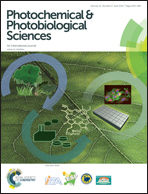Time-resolved fluorescence anisotropy as a tool to study guest–cucurbit[n]uril–protein ternary supramolecular interactions†
Abstract
Ternary supramolecular complexes involving cucurbit[n]urils and proteins are of potential interest for improving drug transport and delivery. We report here time-resolved fluorescence studies for acridine orange complexes with cucurbit[7]uril and cucurbit[8]uril in the presence of human serum albumin as a model system. A detailed characterization of the fluorescence lifetime and anisotropy properties of the different acridine orange complexes with cucurbit[n]urils and human serum albumin was performed. Of particular importance is the analysis of the stepwise binding for acridine orange–cucurbit[8]uril complexes and the assignment of the fluorescence and anisotropy properties to the 2 : 1 complex. Anisotropy decay measurements were essential to detect protein-bound species and to discriminate between different complexes. Based on the fluorescence evidence, ternary interactions with the protein are suggested for the acridine orange–cucurbit[7]uril complex but not for the cucurbit[8]uril complex. We highlight here the usability and sensitivity of the combined fluorescence analysis.
![Graphical abstract: Time-resolved fluorescence anisotropy as a tool to study guest–cucurbit[n]uril–protein ternary supramolecular interactions](/en/Image/Get?imageInfo.ImageType=GA&imageInfo.ImageIdentifier.ManuscriptID=C4PP00479E&imageInfo.ImageIdentifier.Year=2015)

 Please wait while we load your content...
Please wait while we load your content...